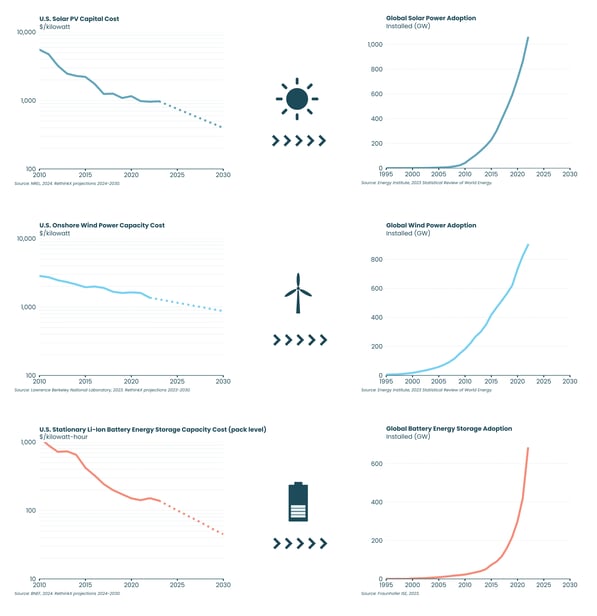No. Battery technologies of various kinds are improving rapidly in cost as they deploy and scale.
Lithium-ion batteries are following a standard experience curve with a learning rate of 17% (i.e. costs fall 17% with each doubling in cumulative production). Other battery technologies based on different chemistries, such as sodium, are also improving rapidly in cost as they deploy and scale. If battery production continues to grow on its current exponential trajectory, we should expect costs to approach $25/kWh between 2020-2030.
- As the cost of both batteries and renewables (solar PV and wind) falls, the combination will become increasingly competitive with coal, gas and nuclear power (shown in the chart below from p26 of our report Rethinking Climate Change).

- Notice that the levelized cost of electricity from batteries charged by solar PV hit cost parity with natural gas peakers at the end of 2017. That happens to be exactly when Tesla installed its first megabattery–the Hornsdale Power Reserve in South Australia.
- Old batteries can be recycled. One way of looking at them is as high-quality metal ore, which means they are a cheaper source of materials than mining lower-quality ore.
In the long run, once we reach the top of the S-curve for both utility and mobile applications, recycling metals will become a larger input stream than mining for new material.
Explore the evidence...
_log%20copy-png.png?width=652&height=5446&name=U-S-%20Stationary%20Li-Ion%20Battery%20Energy%20Storage%20Capacity%20Cost%20(pack%20level)_log%20copy-png.png)
- The cost improvements in solar PV, onshore wind power and lithium-ion battery technologies have been predictable and consistent for over two decades. The combination of incremental improvements in the underlying technology, together with scaling of manufacturing creates a strong correlation between unit cost and production volume, as is common across technologies of many kinds. This is illustrated by the graph below. Find out more on p15 of our Rethinking Energy report.
- Solar and wind are already the cheapest new generation options and cost less than existing coal, gas and nuclear power plants in many areas. The cost of SWB systems will fall another 70% between 2020-2030, making disruption inevitable (see graph below). Read more about this on p8 of our Rethinking Energy report.
- Our analysis conservatively assumes that battery energy storage capacity costs will continue to decline over the course of the 2020s at an average annual rate of 15%. Find out more on p15-16 of our Energy Report.
- 90% of upcoming generation projects waiting to be connected to the network in the U.S. are solar or wind, and 98% of storage is batteries, showing that the cost of batteries is not preventing build-out and the potential for SWB to power our global energy demand. Watch RethinkX co-founder Tony Seba explain this phenomena.
- In our report, we present data to illustrate what 100% SWB would look like in California, Texas and New England as a representative range of solar and wind resources across the U.S. These case studies generalize to nearly all other populated areas of the world, showing the potential for solar, wind and battery power to meet our global energy demand. Read our SWB Regional analysis for more detail.
Take a deeper look at this analysis in our Energy Report:
Witness the transformation
The cost of solar, wind and battery will follow a standard, inevitable experience curve, as with other disruptive technologies throughout history. It will be the cheapest system by 2030. A 100% solar, wind and battery power system is inevitable, and will disproportionately replace the old system with one that has dramatically different architecture, boundaries and capabilities.

_log%20copy-png.png?width=652&height=5446&name=U-S-%20Stationary%20Li-Ion%20Battery%20Energy%20Storage%20Capacity%20Cost%20(pack%20level)_log%20copy-png.png)
